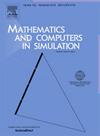Image hiding algorithm based on local binary pattern and compressive sensing
IF 4.4
2区 数学
Q1 COMPUTER SCIENCE, INTERDISCIPLINARY APPLICATIONS
引用次数: 0
Abstract
In recent years, with the rapid growth of digital communication, the protection of image privacy has become a critical concern. Traditional image encryption methods may attract attacker attention due to the noise-like appearance of cipher image. To address the theft risk to the private image, a novel three-dimensional chaotic map of Chebyshev coupled Logistic with Sine map (3D-CCLSM) is designed, and then an image hiding algorithm based on local binary pattern (LBP) and compressive sensing (CS) is proposed, named ImHALC. By integrating LBP-based texture feature extraction and CS-based image compression, ImHALC aims to enhance both the security and imperceptibility for steganographic image. Especially, LBP is taken to connect the plain image and keystream, resulting a high security for ImHALC. Firstly, in stage of keystream generation, texture information of the plain image is extracted by using LBP and seen as input of hash function SHA-256, to produce corresponding hash values. Then, these hash values are used to generate the initial value of 3D-CCLSM by a new designed key transformation model (KAM), so as to get the keystream for encryption. Secondly, in stage of image compression, a measurement matrix is constructed by above keystream, and CS is applied to the plain image to get measurements. Thirdly, in stage of image encryption, measurements are confused and diffused to produce a cipher image. Finally, in stage of embedding, an embedding method using integer wavelet transformation (IWT) and 2k correction is presented, so as to embed the secrets (i.e., cipher image) into a given carrier image to obtain hiding performance, i.e., forming a carrier image hiding secrets (CHS). In particular, the ImHALC can achieve the effect of blind extraction. After adopting a two-dimensional projection gradient algorithm with embedded decryption (2DPG-ED), the reconstruction quality for the plain image is good for test images.
基于局部二值模式和压缩感知的图像隐藏算法
近年来,随着数字通信的快速发展,图像隐私的保护成为人们关注的焦点。传统的图像加密方法由于加密图像具有噪声特征,容易引起攻击者的注意。为了解决隐私图像被盗窃的风险,设计了一种新的切比雪夫耦合Logistic -正弦映射三维混沌映射(3D-CCLSM),并在此基础上提出了一种基于局部二值模式(LBP)和压缩感知(CS)的图像隐藏算法ImHALC。ImHALC将基于lbp的纹理特征提取和基于cs的图像压缩相结合,旨在提高隐写图像的安全性和隐蔽性。特别是采用LBP连接纯图像和密钥流,提高了ImHALC的安全性。首先,在密钥流生成阶段,利用LBP提取平面图像的纹理信息,并将其作为哈希函数SHA-256的输入,生成相应的哈希值。然后,利用这些哈希值通过新设计的密钥转换模型(KAM)生成3D-CCLSM的初始值,从而得到用于加密的密钥流。其次,在图像压缩阶段,利用上述键流构造测量矩阵,并对平面图像应用CS进行测量。第三,在图像加密阶段,测量值被混淆和扩散以产生密码图像。最后,在嵌入阶段,提出了一种利用整数小波变换(IWT)和2k校正的嵌入方法,将秘密(即密码图像)嵌入到给定的载体图像中,以获得隐藏性能,即形成一个载体图像隐藏秘密(CHS)。特别是ImHALC可以达到盲提取的效果。采用二维投影梯度嵌入解密算法(2DPG-ED)后,对测试图像进行了较好的复原。
本文章由计算机程序翻译,如有差异,请以英文原文为准。
求助全文
约1分钟内获得全文
求助全文
来源期刊

Mathematics and Computers in Simulation
数学-计算机:跨学科应用
CiteScore
8.90
自引率
4.30%
发文量
335
审稿时长
54 days
期刊介绍:
The aim of the journal is to provide an international forum for the dissemination of up-to-date information in the fields of the mathematics and computers, in particular (but not exclusively) as they apply to the dynamics of systems, their simulation and scientific computation in general. Published material ranges from short, concise research papers to more general tutorial articles.
Mathematics and Computers in Simulation, published monthly, is the official organ of IMACS, the International Association for Mathematics and Computers in Simulation (Formerly AICA). This Association, founded in 1955 and legally incorporated in 1956 is a member of FIACC (the Five International Associations Coordinating Committee), together with IFIP, IFAV, IFORS and IMEKO.
Topics covered by the journal include mathematical tools in:
•The foundations of systems modelling
•Numerical analysis and the development of algorithms for simulation
They also include considerations about computer hardware for simulation and about special software and compilers.
The journal also publishes articles concerned with specific applications of modelling and simulation in science and engineering, with relevant applied mathematics, the general philosophy of systems simulation, and their impact on disciplinary and interdisciplinary research.
The journal includes a Book Review section -- and a "News on IMACS" section that contains a Calendar of future Conferences/Events and other information about the Association.
 求助内容:
求助内容: 应助结果提醒方式:
应助结果提醒方式:


